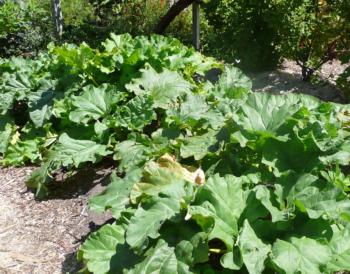Unused stories
Growing In Your Garden Now - Rhubarb

Rhubarb, Rheum rhabarbarum
Planting rhubarb in your landscape is fun because it sports great foliage and the stalks (both green and red) make great pies, crumbles and compotes! A member of the Polygonaceae family like sorrel and buckwheat, rhubarb is native to Russia. The name rhubarb comes from the Greeks who called this plant the vegetable of “barbarians beyond the Rha” (the Volga River). Rhubarb’s edible stalk classifies it as a vegetable although we most frequently cook it as a fruit. The leaves of rhubarb are deadly poisonous and all green matter should be stripped away before preparing the stalk to eat. Oxalic acid is in the leaf, stalk and roots but we can eat the stalk because concentration is not as high. Spinach is another vegetable containing tolerable amounts of oxalic acid.
Rhubarb is a hardy perennial that thrives best where the summers are cool and winters have freezing temperatures. Plants may perish where winters are mild. Stalks emerge in spring after temperatures rise above 50?F. When few local “fruits” are available in March/April, you can count on rhubarb’s first appearance. Think of it as the worlds only “pink” vegetable eaten as a fruit! Plant crown transplants in early spring (March) when rhizomes are available either bare root or in containers. Plants grow vigorously into early summer with consistent moisture. In the fall, when stems die back and the plant goes dormant, remove all plant debris.
The plant’s large glossy green leaves with red veins and stalks make it a perfect and architecturally striking candidate for a sunny exposure border that has some protection from burning afternoon sun. The stalks average about 24 inches high with leaves as wide as 18 inches and attractively pair with a spread of low vegetables. Productive for as long as 20 years, its roots go deep. Crowns may be divided and re-planted every five years or so when the crown begins to work itself up out of the ground and stalk production slows. Do not harvest stalks the first year and select harvest (leave at least 50% of the stalks) in subsequent years because the crowns require nitrogen to produce more stalks next year. Harvest by grasping the stalk at the base and pull and twist upward. Do not cut the stalks because disease can be introduced into the crown when partial stalks are left behind. If rhubarb begins to flower, remove the stalk or production will slow. Conversely, in the edible landscape, when left to bloom, the cream colored flower is very decorative and produces seed.
To plant rhubarb, dig a hole two feet wide by two feet deep and fill in with rich manure and compost. Pack down the organic material to within 12 inches of the top of the hole. Lightly pack in another 12 inches of organic material with pH ranging from 5.0 to 6.8. Plant the rhizomes with “eyes” facing upwards, burying the root two to three inches deep. Keep the area free of weeds, moist and mulch with leaf mold. Subject to few diseases, cultural practices already described help prevent crown rot, leaf spot fungus and viral disease.
The red variety ‘Crimson Red’ grows well in the cool coastal regions of Marin as does ‘Victoria’ which sports green stalks. To cook rhubarb, strip away all green matter from the stalk and cut into one and a half inch sections. Cook for 10 to 15 minutes in a non-reactive saucepan in a 50/50 mixture of sugar and orange juice. You may also add orange peel and cinnamon stick to this delicious compote. Sometimes called the pie plant, rhubarb is also tasty cooked in a pie or covered with a crumbled topping and baked for 45 minutes at 350?F.
By Anne-Marie Walker
